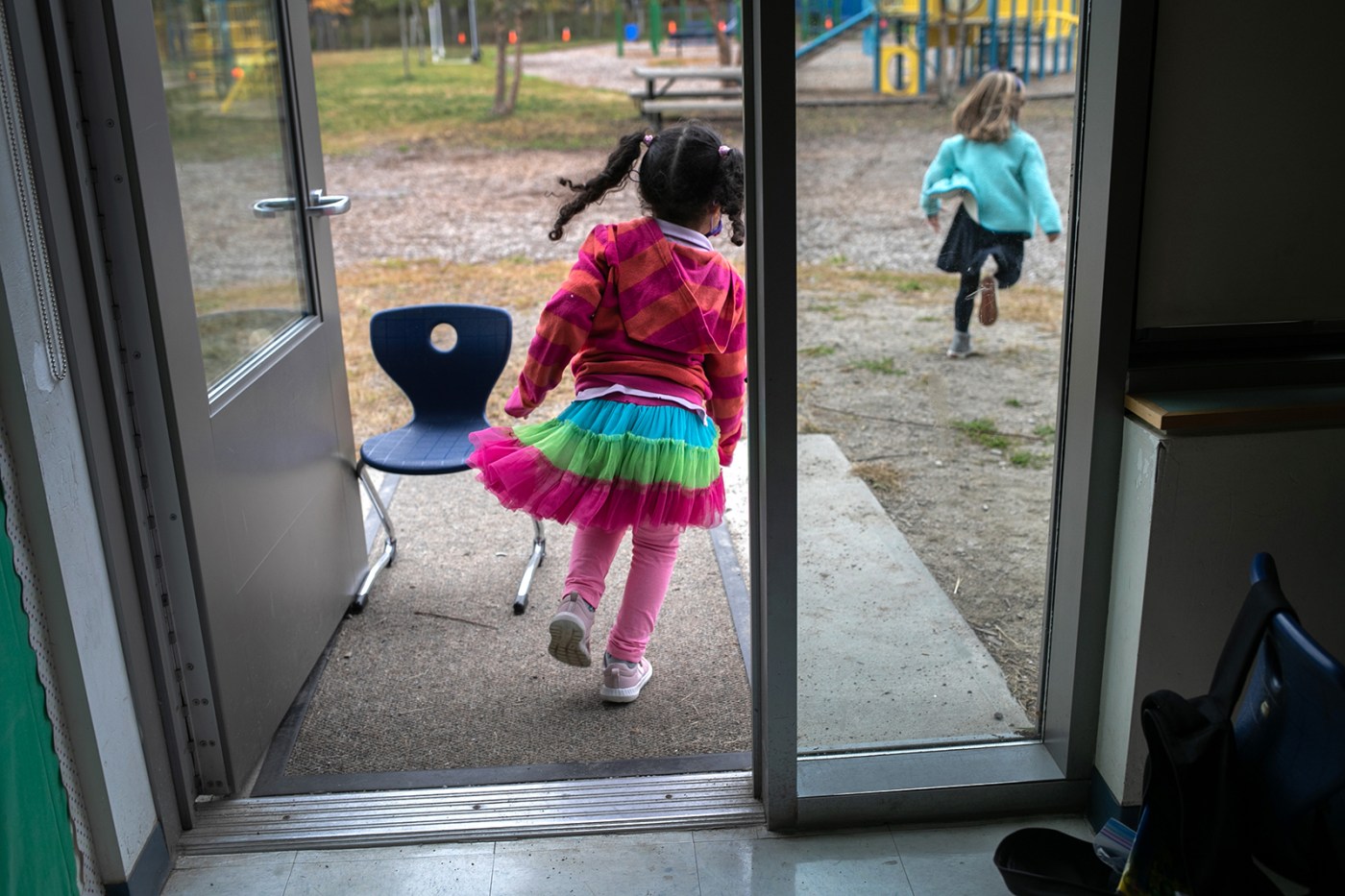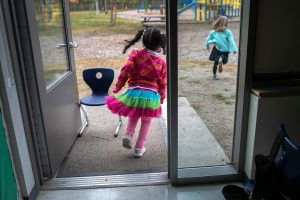
When ‘universal’ pre-K really isn’t: Barriers to participating abound
Elaine S. Povich | Stateline.org (TNS)
When Tanya Gillespie-Lambert goes to an event in a local park in Camden, New Jersey, she takes a handful of brochures about free preschool with her. She has no hesitation about approaching strangers — moms with kids especially — to plug the service in the local public school district, where she’s director of community and parent involvement.
Gillespie-Lambert and her team also hold door-knocking events several times a year to put the word out on free pre-K, dressing up in matching blue T-shirts and hats. That’s in addition to billboards, public service announcements and posters all over town.
“I still get a little shocked when they don’t know about it,” she said in an interview. “They always say, ‘I didn’t know they could start when they were 3 years old, and they don’t have to be potty trained. And it’s free?’”
Forty-four states offer some free preschool, and states from Colorado to Mississippi are expanding their programs. But even when states claim to have “universal” pre-K for 4-year-olds and sometimes 3-year-olds, some of the most comprehensive programs only serve a slice of the kids who are eligible.
There’s a host of reasons for that, beyond a lack of awareness. Some states only provide funding for 10 or 15 hours of preschool per week. Some parents can’t afford the cost of before- and after-care, or have transportation problems if there’s no bus. In some states, private pre-K providers, who often get state money for their pre-K programs, oppose shifting more state funds to public schools. And many states have a shortage of early education teachers and assistants, limiting the number of slots they can provide.
Studies show preschool is highly beneficial for young children, giving them a jump on reading and math skills and the socialization that are key to later school success. Preschool differs from child care, which has less emphasis on academics and often doesn’t employ certified teachers. But private preschool is costly, making it difficult for parents with lower incomes to afford pre-K unless it’s state-funded.
“Everybody doesn’t define ‘universal’ the same way,” said Steven Barnett, senior co-director of the National Institute for Early Education Research at Rutgers University. “You can’t just wave a magic wand.”
Barnett said a state pre-K program should not be considered universal if there’s a cap on funding or a waitlist for slots. He advocates for states to treat pre-K like first grade — automatically available. But providing universal preschool is expensive for states.
Participation varies
More than 1.6 million 3- and 4-year-olds attended state-funded preschools in the 2022-2023 school year, with states serving 7% of 3-year-olds and 35% of 4-year-olds, according to Barnett’s institute.
But participation varies widely from state to state. The number of 4-year-olds enrolled in state-funded pre-K programs in the 2022-2023 school year ranged from a high of 67% in Florida, Iowa, Oklahoma and West Virginia to single digits in Alaska, Missouri, Nevada, Delaware, North Dakota, Arizona, Hawaii and Utah, according to the institute.
Six states have no state-funded preschool: Idaho, Indiana, Montana, New Hampshire, South Dakota and Wyoming.
Related Articles
Best Buy to host Geek Squad camp in Roseville
Belwin Conservancy announces $10M capital campaign to expand access
USC President Carol Folt has her contract extended, despite a tumultuous spring
St. Paul Public Schools is late on its audit. How did that happen and how could that affect the district?
Liberty Classical Academy’s expansion plans raise concerns in northern Washington County
Some states are starting pre-K programs or expanding them. Mississippi doubled the number of kids in preschool in 2022-23 from the previous year to more than 5,300, added another 3,000 seats in 2023-24 and committed to future expansion, according to the state.
Colorado Gov. Jared Polis, a Democrat, signed a universal preschool bill in April 2022, and classes started in the 2023-24 school year. But Colorado’s program provides only 15 hours of free preschool per week in the year before kindergarten.
Similarly, Vermont’s universal pre-K program, enacted in 2014, provides only 10 hours a week of free school.
In addition to being problematic for parents who work 40 hours a week, 10 hours a week of preschool is not enough to provide quality learning, Barnett said. “It has to be a big enough dosage … of truly high-quality education.”
Vermont state Sen. Ruth Hardy, a Democrat, called the program “technically universal” because all 4-year-olds are allowed to participate but acknowledged there are gaps. She filed a bill last year that would have expanded the pre-K program to include full school days but it died, amid other expansions to child care and educational priorities.
Hardy, a former educator and school board member, said in an interview that the legislature did enact a measure to study expanding pre-K to all 3- and 4-year-olds and report back by July 2026.
It was part of a larger law that focused on providing more child care subsidies, including for families with incomes up to “middle-class or close to upper-middle-class levels,” she said. To pay for it, the state instituted a new payroll tax of 0.44%. Employers may choose to pay all of it or deduct up to 0.11% of it from employees’ wages.
Concerns about access
Hardy said that in Vermont, as well as other states, a roadblock to expanding public pre-K programs is the “tension” between public and private schools. Many states take a “mixed delivery” approach to public preschool, under which pre-K is offered in settings ranging from public schools to community-based centers to private schools. But private providers sometimes see expanding the public preschools as competition.
Aly Richards, CEO of Let’s Grow Kids, a Vermont child care advocacy organization, said the group’s concern is equitable access to pre-K programs, especially when parents need kids in all-day instruction and public programs only operate on school-day hours, while private programs often last all workday.
“Working-class families can’t leave their job in the middle of the day if they have to move their kid,” she said.
She also said there is often not enough room in nearby public schools to accommodate all the children who want pre-K programs.
Similar tension is roiling efforts to expand public pre-K in Michigan. Democratic Gov. Gretchen Whitmer and Democratic lawmakers want to make more children eligible, but private schools worry that legislative proposals would eliminate requirements that a percentage of slots go to private providers and thereby cut their state funding.
In Hawaii — which has one of the highest-quality public preschool programs, according to the National Institute for Early Education Research — the problem is getting enough educators into the classrooms.
Hawaii plans to open 44 more classrooms for 3- and 4-year-olds in the fall, bringing the state’s total to about 90, Lt. Gov. Sylvia Luke, a Democrat, said in a statement. But more staffing is needed if the state is going to reach its goal of getting all 3- and 4-year-olds in preschool by 2032, The Associated Press reported.
California is in the third year of a four-year phase-in of a universal pre-K program launched in the 2021-22 state budget. A draft report from the Learning Policy Institute, a California educational research group, found that while most school districts in the state are on track toward getting all 4-year-olds and income-eligible 3-year-olds in pre-K, staffing is a problem and is expected to get worse as new teacher requirements go into effect.
Hanna Melnick, a senior policy adviser at the Learning Policy Institute and one of the co-authors of the report, said it’s unclear how many of the eligible kids are actually taking advantage of the pre-K program.
Some families can’t afford before- and after-care, she said. “Extended care is a really critical barrier. And some families want more of a familylike environment [for their preschoolers]. They might not feel comfortable using out-of-home care or care in a school setting.”
Back in New Jersey, Democratic Gov. Phil Murphy announced in March that an additional $11 million in state funding had been secured to bring preschool to 16 more school districts in the state.
But despite the effort, workers such as Gillespie-Lambert need to keep walking neighborhoods.
“People don’t read,” she said. “We found canvassing — not just flyers, but having a conversation with them — seems to work a lot better.”
Stateline is part of States Newsroom, a national nonprofit news organization focused on state policy.
©2024 States Newsroom. Visit at stateline.org. Distributed by Tribune Content Agency, LLC.


